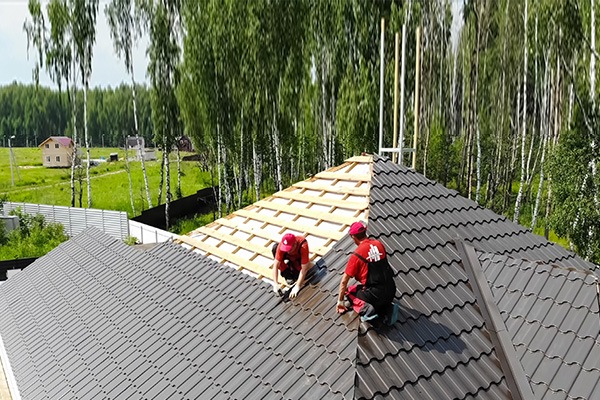Metal roofs are a popular choice among many homeowners due to their durability, power efficiency, and aesthetic appeal. However, as with other types of roofs, regular upkeep is essential to keep it performing properly and looking great for a long time. A well-kept metal roof can provide lasting protection and add value to your property.
With this comprehensive guide, you can learn all about the key steps for metal roof maintenance. Read about the best practices for regularly inspecting your metal roof, cleaning it, and keeping it in good shape.
Understanding Metal Roofs: Types and Benefits
Metal roofs come in several types, each offering unique benefits and characteristics suited to different climates and aesthetic preferences. Aluminum, known for its lightweight nature and resistance to corrosion, is popular in coastal areas where salt exposure can be a concern.
Steel, on the other hand, is valued for its durability and strength, making it suitable for regions prone to severe weather conditions like heavy snow or hail. Copper roofs are prized for their distinctive appearance that evolves over time, developing a coveted patina.
Common characteristics across all metal roofs include exceptional durability and longevity. Unlike traditional roofing materials like asphalt shingles, metal roofs can withstand decades of exposure to the elements without deteriorating. This durability not only reduces the frequency of roof replacements but also minimizes maintenance costs over time.
Furthermore, metal roofs are highly energy-efficient. They reflect solar heat, thereby reducing air conditioning costs. This energy efficiency can contribute to lower utility bills and make metal roofs an environmentally friendly choice.
Beyond their functional benefits, metal roofs offer aesthetic appeal. Available in a diverse array of colors and styles, they can complement various architectural designs, from modern to traditional. The sleek, contemporary look of metal roofing adds curb appeal and can raise the selling price of a home.
Regular Inspection Routine
To ensure your metal roof remains in optimal condition, regular inspections are essential. Aim to conduct bi-annual checks, ideally in the spring and fall, to catch any issues before they escalate. These inspections allow you to identify and address minor concerns such as loose fasteners, small dents, or debris buildup that could potentially lead to more significant damage if left unchecked.
In addition to scheduled inspections, it’s imperative to perform post-storm assessments after severe weather events. High winds, hail, or heavy rainfall can impact your roof’s integrity, causing damage that may not be immediately visible. Look for indications of shifted panels, missing fasteners, or new leaks that could indicate storm-related damage.
Equip yourself with the necessary tools for thorough inspections. Binoculars are handy for assessing the roof’s condition from the ground, minimizing the need to climb up. When climbing onto the roof, use a sturdy ladder and always prioritize safety gear such as non-slip shoes, gloves, and a harness if necessary.
By staying proactive with your inspections, you can nip things in the bud, maximize the lifespan of your roof, and enjoy continued protection for your home.
Identifying Common Issues
Metal roofs are generally robust, but like any roofing material, they can develop issues over time. These are some of the common issues to look out for:
- Corrosion and Rust
One common problem is corrosion and rust. This occurs when the protective coating on the metal wears away, exposing the underlying material to moisture and oxygen.
Regularly inspecting and addressing small rust spots promptly can prevent extensive damage. Applying a rust-resistant primer and paint can help protect the roof from further corrosion.
- Loose or Damaged Panels
Another issue to watch for is loose or damaged panels. Panels can become loose due to high winds, improper installation, or deterioration over time. Signs to look for include visibly shifted panels, unusual gaps, or any rattling noises during windy conditions.
If you notice any loose or damaged panels, it’s vital to secure them immediately to avoid water infiltration and further damage. Tighten screws or replace fasteners as needed, and consult a professional if the damage is extensive.
- Leaks and Moisture Damage
Leaks and moisture damage are also common concerns. Detecting leaks early can help you avert more serious structural issues. Look for water stains on the ceiling, damp spots in the attic, or any mold and mildew growth.
Once a leak is detected, be sure to address it quickly. Repair methods may include sealing the leaks with a waterproof sealant, replacing damaged flashing, or even replacing segments of the roof if necessary.
Cleaning Your Metal Roof
Keeping your metal roof clean is not just about maintaining its appearance but also about prolonging its life. Dirt, debris, and biological growth like moss or algae can trap moisture against the roof surface, leading to corrosion over time. Regular cleaning helps prevent these issues and keeps your roof in good condition.
A good cleaning schedule involves washing your roof at least once a year, preferably in the spring or fall. However, if you live in an area with a lot of trees or frequent storms, more frequent cleanings might be necessary.
For the cleaning process, you’ll need some basic tools and materials. Also, safe cleaning methods are important to avoid damaging the roof. Gentle washing with water and a mild detergent is typically sufficient as an effective cleaning solution.
Avoid using harsh chemicals or high-pressure washers, as these can strip the protective coating off the metal. Instead, use a soft-bristle brush to scrub away any stubborn dirt or grime without scratching your roof.
Finally, having a water hose fitted with an atomizer will disperse the liquid gently yet allow you to rinse the roof thoroughly.
Addressing Surface Damage
Surface damage on a metal roof can take several forms, including scratches, dents, and paint chipping. Scratches can occur from falling branches or debris during storms. Dents are often caused by hail or heavy impacts, and paint chipping can result from normal wear and tear.
Repair techniques vary depending on the type and degree of the damage. For minor scratches, touch-up paint can be an effective solution. This helps to restore the appearance of the roof and prevent rust from developing.
When dealing with dents, it’s important to assess the severity. Small dents can sometimes be pushed out from the underside, but larger dents might require professional repair to make certain that they don’t compromise the roof’s integrity.
Paint chipping is another issue that can be addressed with touch-up paint. However, if large sections of the roof have chipped paint, it might be worth considering a complete repainting of the roof to maintain its protective coating and aesthetic appeal.
In some cases, particularly for extensive damage, seeking professional repair services is the best course of action as roofing professionals have the expertise and tools to carry out repairs safely and effectively.
Seasonal Maintenance Guidelines
Every season will bring specific challenges that can affect the functioning and sturdiness of your metal roof. Here are some maintenance steps to take for each time of year:
- General All-Season Maintenance
Effective year-round preventive maintenance is a must for prolonging the life of your metal roof and avoiding costly repairs.
Trimming overhanging branches regularly is a good way to safeguard your roof exterior. Branches that touch or scrape against the roof can scratch the surface or dislodge protective coatings, making the roof vulnerable to rust and other damage. With the branches trimmed back, you reduce the risk of debris accumulation and potential roof damage during storms.
Another important maintenance task is keeping gutters and downspouts clear. Gutters that are clogged will cause water to back up, damaging your roof and the structural integrity of your home.
Regularly remove leaves, twigs, and other debris from gutters and downspouts for proper drainage at all times. Consider installing protective barriers such as gutter guards to minimize debris buildup and reduce the frequency of gutter cleaning.
- Winter Maintenance
Winter preparations should focus on removing snow and ice buildup to prevent excessive weight that can stress the roof structure. Putting in snow guards is essential for mitigating wintertime hazards. Snow guards prevent large amounts of snow from sliding off the roof at once, which can damage gutters, and landscaping, or pose a safety hazard to people below.
Use a roof rake or hire professionals to safely remove snow without damaging the roof surface. Inspect for signs of ice dams, which can trap water and lead to leaks or structural damage.
- Spring Maintenance
During spring checks, make it a point to clean out debris like pollen, twigs, and leaves from your roof and gutters. These materials can trap moisture and promote mold or algae growth if left unchecked. Inspect for any signs of water damage from winter, such as stains or discoloration, and verify that all flashings and seals are intact.
At the end of spring, prepare for the Summer rains by setting up leaf guards. Leaf guards help keep gutters clear of debris, reducing the risk of clogs and water damage during heavy rainfall. These barriers boost your roof’s overall performance and long-lastingness.
- Summer Maintenance
Summer maintenance involves addressing UV damage, as metal roofs can absorb heat from the sun. This heat absorption can lead to thermal expansion and contraction, potentially causing warping or buckling of the roof panels.
Check the roof for potential damage caused by excessive heat and consider applying a reflective coating to reduce heat absorption and extend the roof’s lifespan.
- Fall Maintenance
Fall preparations include clearing pine needles, leaves, and other litter from your gutters and rooftop, especially during periods of autumn storms. Examine the roof for any worn-out or rickety panels that may have been affected by summer heat or severe weather.
With these seasonal guidelines, you can prepare it for the upcoming challenges and protect your metal roof from typical weathering patterns over changing time periods. These season-specific checks along with the pre-emptive measures every quarter year will make a big difference in retaining the health of your home all year long.
Cost Considerations
Budgeting for metal roof maintenance involves considering both short-term expenses and long-term savings. Regular maintenance tasks such as inspections, cleaning, and minor repairs can typically be handled on a DIY basis, reducing immediate costs.
Equipment like a ladder, safety gear, and cleaning supplies are relatively inexpensive investments compared to the potential costs of neglecting maintenance.
However, there are instances where professional services may be necessary, especially for more complex repairs or extensive damage.
Hiring professionals makes sure that repairs are done correctly and safely, reducing the risk of further damage or accidents. Professional services can be more costly upfront but can save money in the long run by preventing larger issues that require costly repairs or even roof replacement.
All in all, the long-term savings from regular maintenance are significant. By identifying and addressing minor issues early, you can avoid the need for major repairs or premature roof replacement.
A highly maintained metal roof lasts longer and performs better, which can potentially lower your insurance premiums due to reduced risk of damage as well as increase your property’s total worth.
When to Call a Roofing Professional
Knowing when to get professional help for your metal roof upkeep can save you significant amounts of time, money, and headaches. Signs that require expert attention include severe leaks that are causing water damage inside your home or extensive corrosion that compromises the entire stability of your roof.
When choosing a contractor, look for credentials such as licenses, insurance, and certifications. Ask for references and examples of past work to confirm that they have experience with metal roof repairs. Additionally, ask specific questions about their repair process, warranties offered, and how they handle unexpected challenges.
Expert Metal Roof Maintenance by Harvey’s Five Star Roofing
With the maintenance tips for your metal roof outlined in this guide and knowing when to call in the experts, you can preserve your investment for the long term. Consistent assessments, clear-outs, and fixing problems promptly are key to keeping your roof in tip-top shape.
If you need any help with your metal roof upkeep, call Harvey’s Five Star Roofing at (712) 832-3660 today for expert assistance. We are your trusted roofing professional who can come by and provide you with precise advice on your metal roof care, specific to your roof type and climate.
Whether it’s residential or commercial roofing services you need, we’ll take excellent care of your metal roof, giving your family and business peace of mind for years to come.









